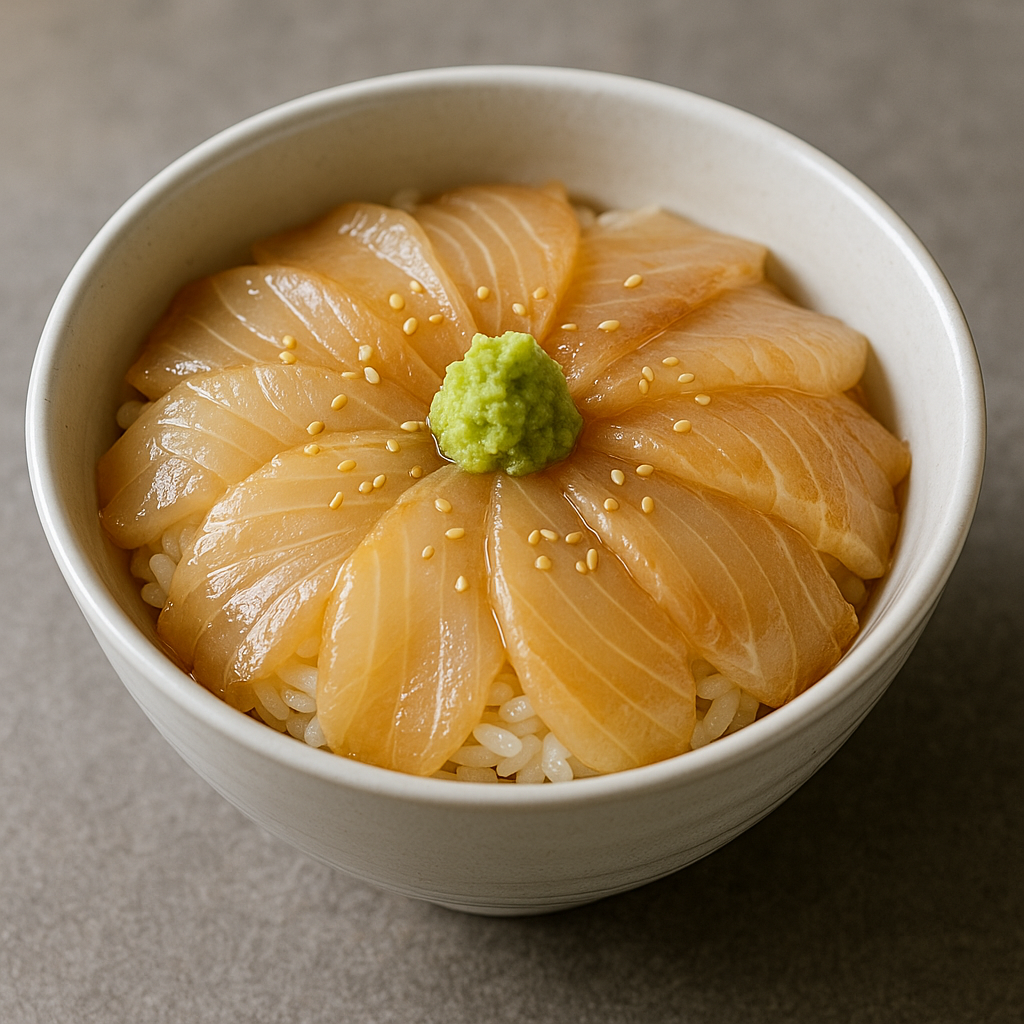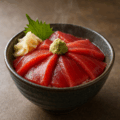鰺ヶ沢ヒラメ漬け丼の特徴
津軽西海岸・鰺ヶ沢の新鮮な白身
鰺ヶ沢の海で水揚げされる新鮮なヒラメを活かした丼。透き通るような白身の美しさと、しっとり上品な旨みを楽しめます。
短時間漬けで引き出す上品な旨み
煮切り醤油のタレに1〜3分だけくぐらせる短時間漬け。昆布の旨みがほのかに移り、米との一体感が心地よい仕上がりになります。
卵黄・大葉・わさびで香りとコク
卵黄でコクを、わさびと大葉で香りの輪郭を加えます。刻み海苔と白ごまで風味のバランスが整います。
鰺ヶ沢ヒラメ漬け丼のレシピ
材料(2人分)
- ヒラメ(刺身用) … 200g(5〜6mm厚のそぎ切り)
- ご飯 … 2膳分
- 大葉 … 4枚(千切り)
- 刻み海苔 … 適量
- 白ごま … 少々
- わさび … 適量
漬けダレ(煮切り)
- 醤油 … 大さじ2
- みりん … 大さじ1
- 酒 … 大さじ1
- 砂糖 … 小さじ1/2(お好みで)
- 昆布 … 5cm角 1枚
作り方
- 小鍋でみりんと酒を軽く煮立ててアルコールを飛ばす(煮切り)。火を止め、醤油・砂糖・昆布を加えて粗熱を取り、よく冷やす。
- ヒラメを5〜6mm厚のそぎ切りにし、冷えた漬けダレに1〜3分だけくぐらせる(色と艶を保つため短時間)。
- 器に温かいご飯を盛り、刻み海苔と大葉をのせる。
- ヒラメを美しく並べ、白ごまを振る。中央にわさびを添える。
- 仕上げに漬けダレを少量(5〜10ml)回しかけて完成。
シェフのワンポイントアドバイス
身は5〜6mmが食感と舌触りのバランスが良好。みりんと酒は必ず煮切って角を取り、タレはしっかり冷ましてから使うと身が締まりすぎません。
ヒラメの脂肪分が足りない時にはごま油を少し加えるとコクが出ます。
鰺ヶ沢ヒラメ漬け丼の栄養価(1人分の目安)
- エネルギー:約420〜520 kcal(卵黄あり)
- たんぱく質:28〜32 g
- 脂質:8〜12 g
- 炭水化物:55〜65 g(ご飯由来)
- ビタミンD・B群(魚由来)
- EPA・DHA(白身魚由来、血流や認知機能の維持に寄与)
高たんぱくで比較的低脂質。タレの量を調整すれば塩分コントロールもしやすい一品です。
鰺ヶ沢ヒラメ漬け丼の歴史
漁港町に根づく“漬け”文化
鮮度を保つ知恵として発達した“漬け”の技法を丼へ応用。やさしい調味が旨みを引き立てます。
食堂から家庭へ
市場食堂や寿司店で人気を博し、現在は家庭でも手軽に楽しまれる丼として定着しました。
津軽西海岸・鰺ヶ沢の名物海鮮丼
新鮮な白身の産地背景を活かし、観光地や漁港近くの食堂で提供される地域色豊かな名物丼です。
English Version
Features of Ajigasawa Marinated Flounder Bowl
Fresh White Fish from Ajigasawa on the Tsugaru Coast
This bowl showcases fresh flounder landed off Ajigasawa on the Tsugaru west coast. Enjoy its translucent white flesh and refined, gently rich umami.
Refined Umami from a Quick Marinade
The fish is briefly dipped in a nikiri soy-based sauce for 1–3 minutes. A subtle touch of kombu deepens flavor and brings a pleasing harmony with warm rice.
Aroma and Richness with Egg Yolk, Shiso, and Wasabi
Egg yolk adds richness while wasabi and shiso sharpen the aroma. Shredded nori and a light sprinkle of white sesame balance the flavors.
Recipe
Ingredients (for 2 servings)
- Flounder (sashimi-grade) … 200 g (sliced 5–6 mm thick)
- Steamed rice … 2 bowls
- Shiso leaves … 4 (finely sliced)
- Shredded nori … to taste
- White sesame … a little
- Wasabi … to taste
Marinade (Nikiri)
- Soy sauce … 2 tbsp
- Mirin … 1 tbsp
- Sake … 1 tbsp
- Sugar … 1/2 tsp (optional)
- Kombu … 1 piece (5 cm square)
Instructions
- Gently boil mirin and sake in a small pan to evaporate alcohol (nikiri). Remove from heat, add soy sauce, sugar, and kombu. Let cool completely.
- Slice the flounder 5–6 mm thick and dip in the chilled marinade for 1–3 minutes to coat without discoloration.
- Place warm rice in bowls and top with shredded nori and sliced shiso.
- Arrange the flounder neatly and sprinkle with white sesame. The center a dab of wasabi.
- Finish with a light drizzle of marinade (about 5–10 ml).
Chef’s Tip
5–6 mm slices balance bite and mouthfeel. Always nikiri the mirin and sake to round off sharp edges, and cool the marinade before use so the fish doesn’t tighten. For leaner fillets, a few drops of sesame oil in the sauce can add body.
Nutritional Value (per serving, approx.)
- Calories: 420–520 kcal (with egg yolk)
- Protein: 28–32 g
- Fat: 8–12 g
- Carbohydrates: 55–65 g (mainly from rice)
- Vitamin D & B group (from fish)
- EPA & DHA (from white fish; support circulation and cognitive function)
High in protein and relatively low in fat. Adjusting the sauce amount makes salt control easy.
Historical Background
Marination Culture Rooted in Port Towns
Originally a method to preserve freshness, gentle “zuke” seasoning was adapted to rice bowls, highlighting the fish’s umami.
From Eateries to Home Kitchens
Popular at market diners and sushi shops, it has become a simple yet refined dish enjoyed at home.
A Regional Specialty of Ajigasawa on the Tsugaru West Coast
Leveraging a rich supply of fresh white fish, this bowl is served at eateries near fishing ports and tourist spots as a beloved local specialty.



何でも質問してください!